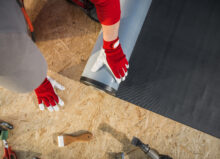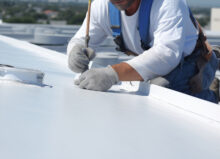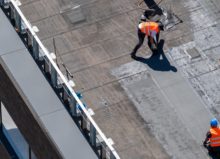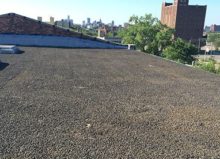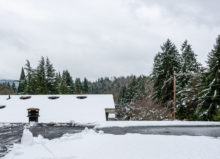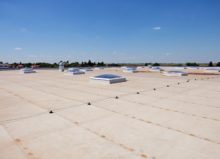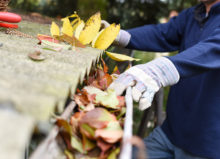Essential Spring Commercial Roof Maintenance Tips

Routine industrial and commercial roof maintenance leads to long-term savings on repairs and utility bills, reduces downtime, and helps to ensure the maximum service life of a roof and the structure it protects. This spring, protect your roof by practicing these essential flat roof maintenance tips:
Remove Fallen Leaves & Debris
Freezing temperatures, high winds, and ice and snow accumulation during the winter can cause sticks, trash, and other rubble to build up on a roof. Keeping your roof free of debris and pooled water eliminates the possibility of it freezing up and clogging your drains, gutters, and downspouts and causing additional water and structural damage.
If you can safely access your commercial flat roof, then do so with caution and a Safety-First mindset. Ensure proper ladder positioning and stability, and avoid the roof’s edges. Don’t go out of your way to remove debris if it is in a dangerous location—your safety should come first. If you have any doubts, please call a professional roofer.
Check Gutters for Clogs
When a roof’s gutter system is clogged, it causes water that should drain away from the roof and the building to back up, possibly flowing backward, up the pitch of the roof, under the roofing membrane. It can also cause water to flow back onto the top of the roof and pool up there, adding extra weight.
If this happens once, it may not cause any serious damage. However, if it happens consistently, the subsurface of the roof will begin to degrade, increasing the probability of roof failure.
If it’s safe for you to do so, perform the following gutter system maintenance tasks:
- Complete routine visual inspections of your gutters, downspouts, drains, and scuppers.
- Ensure that your gutters and downspouts are properly affixed to the building.
- Keep all trees and shrubs cut back from the roof by at least three feet.
- Keep an eye on loose seams, slack fittings, corrosion, and stains.
If your gutter system is performing poorly due to frequent clogging, ask your roofing contractor about installing a commercial gutter guard. It’s easy to install, cost-effective, and significantly improves the function and lifespan of the entire roofing/drainage system.
Identify Loose Flashing or Missing Nails
The cold temperatures of winter can cause metal flashing to contract or cause water to freeze underneath it, either of which can cause the flashing to pull up on the heads of nails and screws, causing them to loosen. As the process of freezing/contracting/pulling continues, the flashing progressively loosens.
Roof flashing may also get wrinkled or otherwise contorted from the natural shifting of the earth the structure is built on. A small foundational change at ground level can put substantial stress on flashing that could be dozens or more stories up.
Whatever causes it, loose roof flashing is not good. The best flashing is installed tight and right, with no potential for allowing rain, snow, debris, or even insects underneath.
That’s why you should conduct periodic visual inspections of the surface of your roof, scanning for loosened or “popped” nails or screws.
While it is sometimes possible to hammer a loose nail down or retighten a loose screw, it’s typically best to relocate the affixer to a nearby spot that’s solid and new and then cap the head with a quality elastomeric sealant.
There’s also the possibility that a loosened nail or screw causes damage to the roofing membrane. Keep your eyes open for cuts, tears, rips, punctures, or other damage to the membrane (or flashing) that might allow water to penetrate and cause further damage.
Remove Animal Nests
Keeping animal nests cleared away is another important facet of commercial roof maintenance. It’s common for birds, squirrels, chipmunks, raccoons, and other springtime creatures to begin building nests where they believe they can find shelter, protection from predators, and warmth.
When left unchecked, they can cause severe clogging and water damage. It’s good to catch them in the process early to keep the nests from becoming more burdensome to remove, and it gives the animals a better opportunity and more time to find another place to reside.
Aside from obvious nest building, you can also look for paw prints, fecal droppings, and signs of chewing or gnawing to determine the presence of cute but unwelcome roof inhabitants.
Schedule Inspections After Heavy Rain or Storms
Those of us who live in Michigan know that brutal wind, torrential rain, unpredictable thunderstorms, and even tornados are likely during springtime. And that all comes after our long, cold winters. It’s important to have your commercial roofing system professionally inspected at least once annually and any time after you’ve experienced inclement weather. Remember—being proactive will be more cost-effective for you in the long run.
Request a Professional Inspection Today
While it’s wise for every business owner to take care of basic commercial roof maintenance duties, there’s no substitute for the experience of a professional roofer. Contact Summit Commercial Roofing to schedule your commercial roof inspection. We’re a family-owned and -operated roofing company specializing in commercial flat roofing, and we proudly serve businesses throughout Southeast Michigan.


